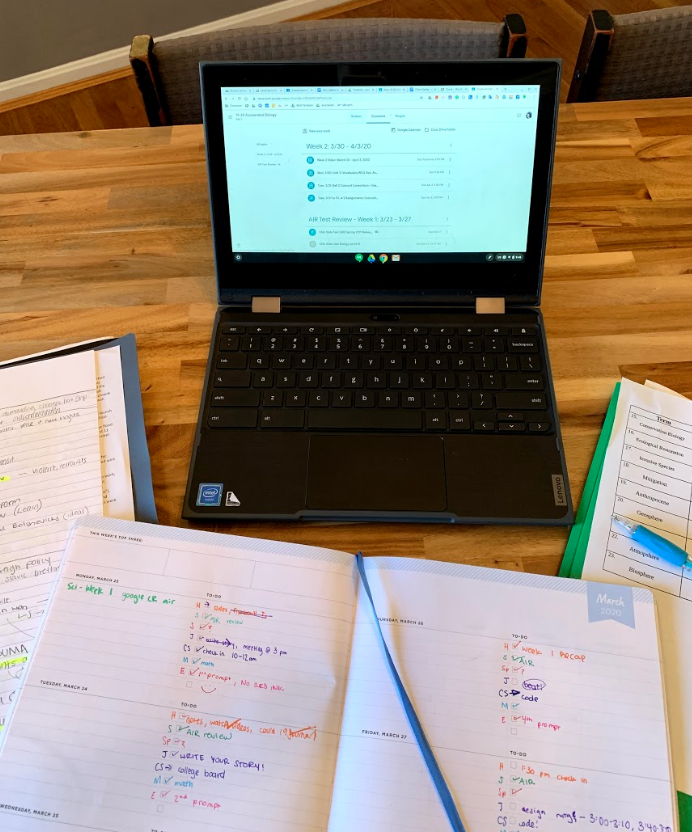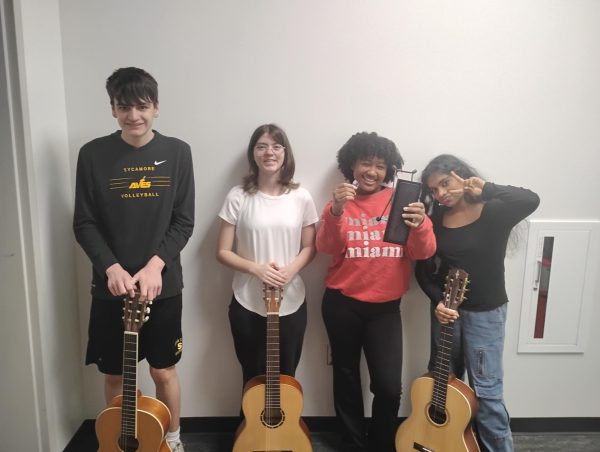Teachers discuss their thoughts on remote learning
REMOTE LEARNING. Pictured above is the work environment of a student who is learning from home. Teachers are learning how to teach in this new situation. English teacher Mrs. Beth LeBlanc said, “Online learning is challenging because face to face discussions and group work is an essential part of a language arts class, and that’s tough to replicate with technology. It’s also been a bit challenging because many students and their families have challenging situations at home, and we want to be mindful so we’re supporting families and not adding stress.”
Remote learning: this is a new experience for all students. And for all teachers. They have to find a way to teach from home, miles away from their students, unlike the usual, at most, 15 feet. So, how do you accomplish this?
The first thing to consider is the assignment. Social studies teacher Mr. Nicholas Hellwig said, “I start out with what the standards are and what I want the students to learn by the end of the activity. Then I look at how to do that and build from there.”
Science teacher Mrs. Mary Palmer said she has found good online resources that teachers can easily assign and check-in on students’ progress. She also used some creativity to make “new lessons for the new learning.”
The next thing to consider is the due date. Do you have students complete smaller assignments by the end of the day, or do you have a week’s worth of work due Friday? Palmer assigned work for each day, and Hellwig and English teacher Mrs. Beth LeBlanc assigned work for the week.
Palmer felt that doing small assignments each day would be “the best approach,” but provides flexibility if the student needs it, and they communicate with her.
On the other hand, Mr. Hellwig thought that since “there is a lot going on,” he wanted to let students figure out how they will learn best in this situation. Whether that means doing social studies all at one time or spreading it out, he felt that giving that option allows for “greater involvement in the material.”
LeBlanc agreed, saying that the freshman language arts teachers anticipated unique situations at home that may conflict with a daily due date. She said, “We liked the idea of students only having to remember one, the consistent due date for language arts class while they’re learning at home.”
Online learning comes with its own set of challenges. LeBlanc said, “Online learning is challenging because face to face discussions and group work is an essential part of a language arts class, and that’s tough to replicate with technology. It’s also been a bit challenging because many students and their families have challenging situations at home, and we want to be mindful so we’re supporting families and not adding stress.”
Hellwig said challenges with remote learning include “making sure everyone is doing it and understanding, not copying off each other, [and finding out] how to assess learning.” Also, “trying to interact with the students” and making sure his own kids complete their assignments.
Even with these challenges, Palmer thinks, given more time, students and teachers will get better at remote learning. “I think [students] are learning but in a different way. That is a good thing because it shows that we can learn in a flexible manner when we need to,” Palmer said.
Whether or not a student learns as much with online learning as they would in school, depends on the student. “Students who are motivated to learn can do it on their own,” Hellwig said. Still, “I think most people benefit from the interaction and discussions with teachers and other students. Another student’s question unlocks deeper conversations that you [can] replicate online as easily.”
Even though teachers are finding ways to engage students through remote learning, being in the classroom still sets the bar. “I really miss being around students on a daily basis. My teaching methods are based more in a hands-on, small group [projects] and an active learning model. That is harder to do online, but I would imagine with all the technology around that it would be possible to do that remotely,” Palmer said.
Your donation will support the student journalists of Sycamore High School. Your contribution will allow us to purchase equipment and cover our annual website hosting costs.











